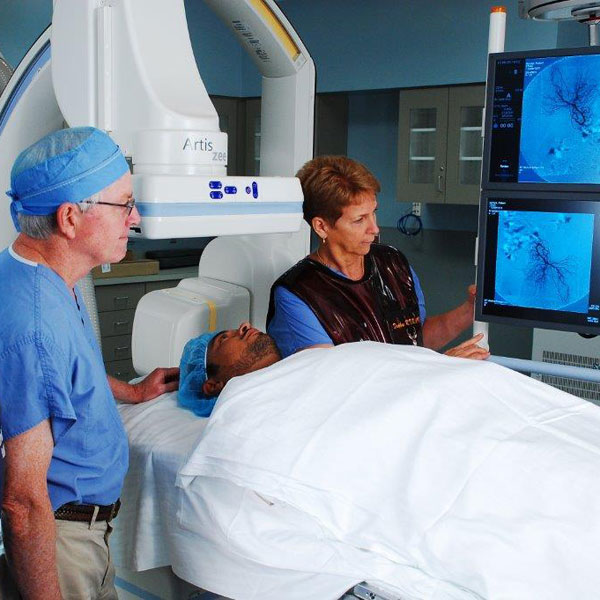Men’s Health Interventions
There are times when men need interventional radiology procedures to fix problems related to urinary or reproductive health, including vein disorders that can result in fertility problems. Triad offers men access to treatments created especially for them, using state-of-the-art equipment in a professional environment.
Varicocele Embolization
A varicocele is an enlarged and lengthened vein within the scrotum. These veins contain one-way valves that allow blood to flow from the scrotum/testicles back to the heart. When the valves malfunction, the blood pools in the veins, which can lead to pain, testicular atrophy (shrinkage), or fertility problems.
A varicocele embolization is a nonsurgical treatment used to divert blood flow away from a varicocele. During varicocele embolization, your Interventional Radiologist will numb the entry point and then guide a catheter into the faulty vein. Then, small coils and a scarring solution will be inserted into the vein to block it. By blocking the faulty vein, blood is able to be diverted to healthy veins so it can exit the testicle through normal pathways. This results in reduction in swelling and pressure within the testicle and most times resolution of fertility issues. This procedure is performed as an outpatient.
Benign prostatic hyperplasia (BPH), or benign prostatic hypertrophy, is an enlargement of the prostate, a walnut-sized gland that forms part of the male reproductive system. It is the most common disorder of the prostate gland and the most common diagnosis by urologists for males between the ages of 45 and 74. If left untreated, BPH could lead to urinary tract infections, bladder or kidney damage, and bladder stones or incontinence.
When symptoms are mild, BPH may not require treatment. Some men, however, require immediate intervention to treat the symptoms.
There are several surgical techniques that may be used to treat an enlarged prostate. However, some men may be able to be treated with a newer, minimally-invasive technique called prostate artery embolization (PAE). A big advantage of PAE is that it can greatly reduce BPH symptoms without the side effects of traditional prostate surgery.
For this procedure, an Interventional Radiologist inserts a hollow wire into the artery in the groin and maneuvers it to the arteries that only supply the prostate. The radiologist will then inject material to slow or stop blood flow to the prostate, which can cause it to shrink or soften.
Prostate artery embolization is typically done as an outpatient procedure. However, there may be times when an overnight stay in the hospital is necessary.
Triad Radiology offers Men’s Health Interventions at a variety of locations, including hospitals, imaging centers, and clinics. Contact us if you want to learn more or schedule an appointment.



